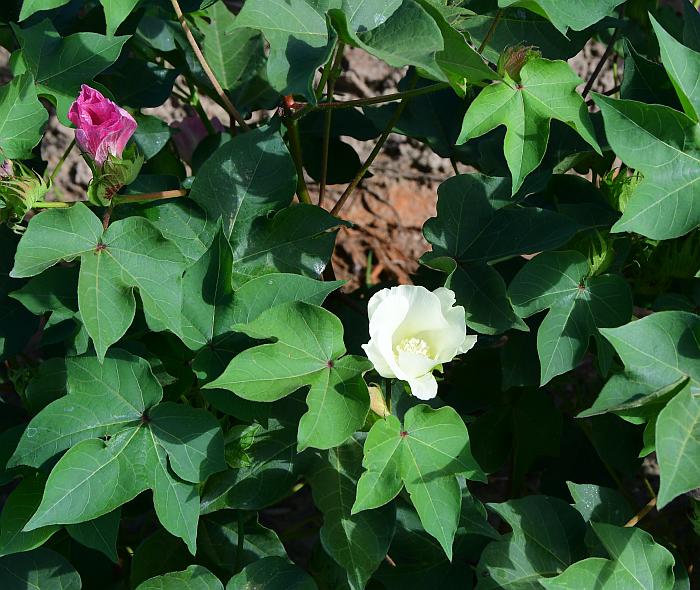Gossypium hirsutum L.
Upland Cotton

Introduced
CC = *
CW = 5
MOC = 7
© SRTurner
Gossypium hirsutum L.Upland Cotton | |
 |
Introduced CC = * CW = 5 MOC = 7 |
© SRTurner |
|
Family - Malvaceae Habit - Annual forb. Stem - Ascending to erect, to 1.3 m, usually branched, pubescent with spreading, simple or fasciculate hairs.
Leaves - Alternate, long-petiolate. Blades 3-10 cm long, broadly ovate to nearly circular in outline, 3-or 5-lobed, the base cordate, the lobes broadly triangular, tapered to pointed tips, the margins entire, the surfaces pubescent with sparse to dense stellate hairs. Stipules tending to shrivel before flowering, 3-9 mm long, linear to elliptic-lanceolate.
Inflorescences - Flowers solitary or in small clusters in the leaf axils, the bractlets subtending the calyx 3, conspicuous and exceeding the calyx, 20-45 mm long, broadly ovate-cordate, overlapping, the margins incised with deep narrow lobes. Flowers - Calyces 5-24 mm long, cup-shaped at fruiting, the sepals fused nearly to the tip, the lobes broadly triangular. Petals 25-55 mm long, the tips broadly rounded, the margin usually slightly irregular, white or more commonly pale yellow, sometimes pinkish- or purplish-tinged, often with minute dark glandular dots. Stamens numerous, the staminal column circular in cross-section, with a low crown of teeth at the tip, the anthers yellow. Pistils with 3-5 locules, the carpels closely fused. Style unbranched, with 3-5 linear longitudinal stigmatic areas toward the tip.
Fruits - Capsules, broadly ovoid to nearly globose, dehiscing longitudinally from the tip, glabrous. Seeds 5-11 per locule, 7-10 mm long, narrowly obovoid, the body hidden by a dense covering of shorter white matted hairs and long fluffy white fibrous hairs.
Flowering - July - September. Habitat - Roadsides, railroads, open disturbed areas. Widely cultivated and escaping sporadically. Origin - Native to Mexico and the Caribbean. Lookalikes - None. Other info. - Cotton has been cultivated since antiquity. In Missouri it is grown in the Mississippi Lowlands region and adjacent Ozark counties. Escapes from cultivation are rare. The plant is recognized by its large, Malvaceae-patterned flowers having a distinct staminal column, and leaves with large, triangular lobes. Photographs taken along a roadside near Dexter, Stoddard County, MO, 11-2-2008, and near Holly Ridge Conservation Area, Stoddard County, MO, 8-15-2021 and 8-7-2022 (SRTurner). |